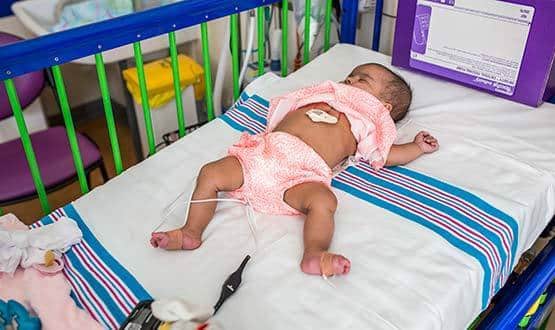Birmingham Children’s Hospital NHS Foundation Trust will roll-out personalised wireless monitoring of sick kids, with an early warning system that can alert clinician’s hours before a life threatening event.
The trust is midway through a three year research study using Isansys Lifecare wireless sensors to track a child patient’s vital signs, such as heart rate, breathing rate and oxygen levels, in real time. The data is transmitted via Bluetooth to a gateway located by the bedside.
During a site visit by Digital Health News, project lead Dr Heather Duncan said Birmingham Children's is the only children’s hospital in the world using wireless-sensor based warning system. Similar Isansys Patient Status Engines are already being used to monitor adult cancer patients, stroke patients and others both in the UK and abroad.
Duncan said while the potential pay-off was huge it was still early days, and making the system work in practise was difficult, particularly for such a variable group as sick children. “This is the first time that wireless monitor has been done with children,” she said. “So there wasn’t a system we could buy off the shelf.”
The project has run into data loss issues, with the tablets, designed to be a consumer rather medical product, going to sleep and the sensors being knocked loose by wriggling children.
So far, the alerts have also worked off standardised measures but most of their hospital’s patients were “normally abnormal”, leading to a lot of false alarms, Duncan said.
At the bedside of a young girl with a congenital heart condition, Duncan points out that the patients oxygen levels are at alert level according to her bedside display. “That’s a false alarm for her, and that’s one of the problems. We need to set the alarm right for babies that are normally abnormal.”
The next step is to use the growing data stream, which now includes the vital signs 570 patients that have participated in the trial, to solve that problem in the next few months.
Using algorithms that take into account the patient’s condition and vital signs, along with data gathered from others in the study cohort, patients will have their own calibrated early warning system.
These algorithms have already been tested in retrospect against the vital signs of patients in the lead-up to a real life threatening event. Hours out, long before clinicians were likely to notice anything untoward, the algorithms were generating clear patterns indicating something was amiss. “That is maths that will save lives.”
Data loss has also now fallen from more than 60% to more respectable 20%; comparable to wearable fitness devices. If the study proves effective, the hope is to scale it up to include all patients at the hospital.
The study, known as The Real-Time Adaptive and Predictive Indicator of Deterioration, or Rapid, is funded by a £1.8 million grant from the Wellcome Trust and the Department of Health through the Health Innovation Challenge Fund to accelerate the translation of innovated technology into practical clinical applications.
As well as the hospital, Isansys Lifecare, McLaren Applied Technologies, Aston University and the University of Birmingham are all involved in developing Rapid.
The study started about 18 months ago year ago and has recruited 570 patients from the trust’s cardiac wards. The aim is to have recruited about 1,200 patients by the time it is completed in 2017.
For now, the data gathered isn’t integrated into any other patient records, largely because the trust is yet to be roll-out an electronic patient record. This is expected to take place in this financial year.
The trust is also working on a paediatric version of the PICS system developed by neighbouring University Hospitals Birmingham NHS Foundation Trust, with support from the 'Safer Hospitals: Safer Wards: Technology Fund.' The early warning system, if it proves effective, will be plugged into the wider EPR.
How it works:
Wireless devices are attached to the patient’s chest and leg, to monitor heart rate, breathing rate and oxygen levels.
This information is sent by Bluetooth to a repurposed Android tablet at the bedside and to a secure Isansys Lifecare server.
Using McLaren’s data analytics platform, the same base technology used to monitor Formula One racing cars, the data can also be used in send early warning signs to clinicians that a patient is deteriorating.
Patients can go home with the sensors; the data is uploaded once they return to the hospital.

